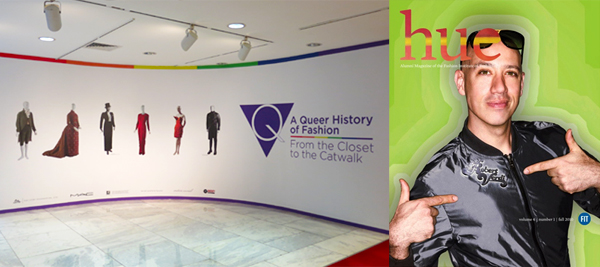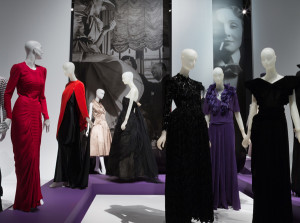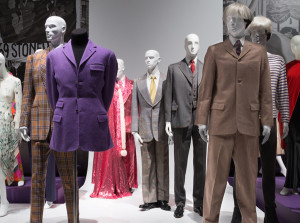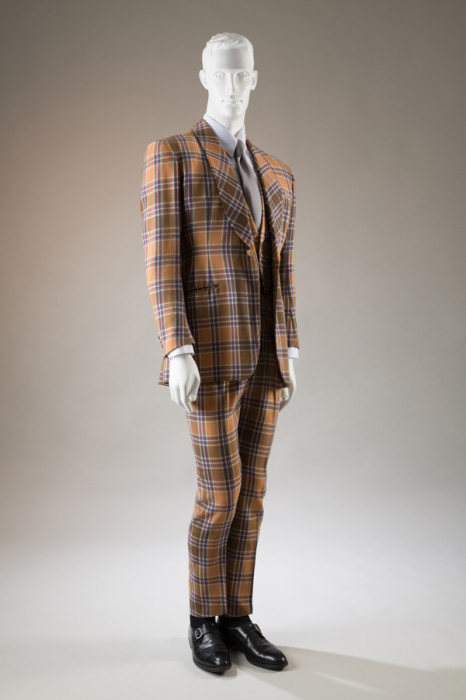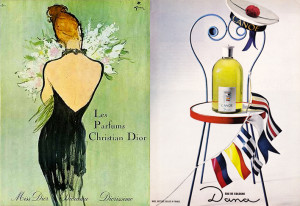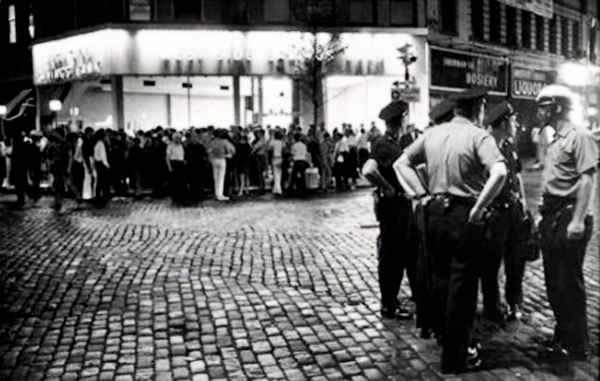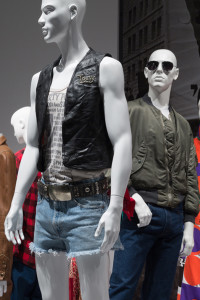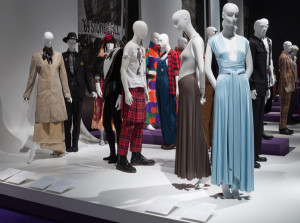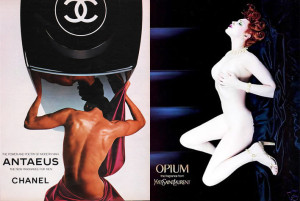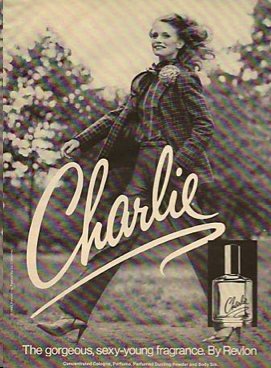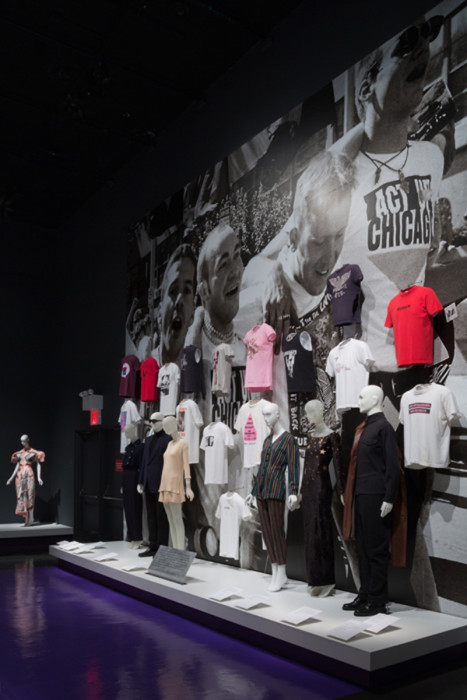Queer History of Fashion Exhibit at FIT
Douglas Bender of Charenton Macerations and CaFleureBon Contributor introduced our readers to A Queer History of Fashion: From the Closet to the Catwalk, on view at The Museum at FIT now through January 4th, 2014 on 12/12/13. Co-Curators Valerie Steele and Fred Dennis, as well as style icon Robert Verdi walked the show with Douglas adding additional insights to the displays of fashion at the exhibit. Part 1 examined proto LGTBQ fashion and fragrances of the late 19th century through the Pre War era dubbed Pushing Boundaries: Mollies, Dandies & Les Garçonnes –Michelyn Camen, Editor in Chief
1950s Gay Designers Installation View. Photo courtesy The Museum at FIT
The Post-War “Normal” & Its Subversions
In the postwar period, as the exhibition notes, there was a change in the cultural tone. As co-curator Valerie Steele remarked during the exhibition’s two-day symposium: "The postwar period was characterized by a real culture of very strong right-wing reactions against gays and lesbians… much stronger than in the case of the 20s and 30s. So it’s not just that fashion and society became gradually more welcoming. There have always been these back-and-forth movements where greater tolerance was followed by greater repression, and the 50s were a real period of witch hunts. So, fearing exposure, most homosexuals became, in effect, invisible men. Lesbians as well tended to try and conceal their sexual identity". Though closeted to most outsiders, the period is noted in the exhibition for the rise of gay designers. Christian Dior, Cristóbal Balenciaga, and Edward Molyneux were cornerstones of women’s fashion haute couture, responsible in many ways for defining the period’s feminine styles, and are now known to have been gay. Examples of their work displayed in this section highlight the beauty of their skill in crafting women’s fashions.
Pre-Stonewall Installation View. Photo courtesy The Museum at FIT
The broader cultural shift toward repression was reflected in LGBTQ subcultural fashions. Instead of the bold, transgressive displays of the dandies, belonging in queer communities was signaled by subtler, or as Verdi describes, “nuanced” codes. Where the dandies had green carnations, in the postwar period, pieces of fashion like a red necktie or suede shoes became the secret signifiers men would use to communicate their identities in ways that were invisible to straight society. This type of fashion as covert communication continued, as Robert Verdi notes, “up into the 1970s when there was the hanky code, that indicated sexual interests, but… if you weren’t gay you might not know.”
Check tartan wool suit worn by Bunny Roger, 1973, England, lent by Hamish Bowles. Photo courtesy the Museum at FIT
The period was not bereft of subversion, however. Gay men working in fashion at the time, though almost all in the closet, started the “Peacock Revolution,” introducing colors, patterns and fabrics, like velvet, which had been historically associated with feminine style, into menswear. Representing this moment, the exhibition includes a wool suited look worn by fashion photographer Cecil Beaton, as well as a tartan suit with a tailored cinched waist by English couturier, Bunny Roger.
Left: (Ultra Feminine) Vintage Dior perfume ad Miss Dior and Diorissimo by Rene Gruau and Uber Masculine Dana Canoe represent gender marketing from the late 1930s to mid 1960s
These subversive moments notwithstanding, fragrance after World War II reflected the broader solidification of normative gender roles in the culture. Distinctions between what were considered masculine fragrances and feminine fragrances became more defined. For women’s fragrance, the provocative chypre of the 1920s was now sheered and restructured away from leathery tobaccos toward a sharper green aldehydic, like the green chypre of Dior’s Miss Dior (1947). Florals became the archetypical symbol for femininity, exemplified by scents like Nina Ricci’s L’Air du Temps (1948), Dior’s Diorissimo (1956), and Hermès’ Calèche (1961). Similarly, the fougère came to typify men’s fragrance, thanks to scents like Dana’s Canoe (1936) and Fabergé’s Brut (1964). Fougères, citrus-based colognes, and wood-based chypres became an established repertoire for the scents of a man.
The scene in the West Village during the 1969 Stonewall Riots
After Stonewall (The Riots of 1969)
The Stonewall Riots in the 1969 were a watershed moment in the history of gay and lesbian rights. On June 28, 1969, NYPD and Alcoholic Beverage Control Board agents entered The Stonewall Inn at 51-53 Christopher Street, allegedly looking for violations of the alcohol control laws. The night was supposed to be a routine raid, the sort of thing that frequently punctuated gay nightlife. However, on this night, tensions escalated and, instead of quietly slipping away into the night, hustlers, drag queens, students and other Stonewall patrons fought back. That night has come to be remembered as the catalyst for the modern gay and lesbian rights movement. In Stonewall’s wake, queer style began to pursue new trajectories. As Steele notes: "Pre-Stonewall, the most visible gay male styles were the elegant camp or drag, and Post-Stonewall, the ‘clone’ emerged to symbolize modern ‘macho’ gay style. Lesbian style also evolved as traditional butch/femme dress codes were increasingly replaced by androgynous, anti-fashion styles. And then, over time, LGBTQ style also diversified under the influence of subcultures such as punk and disco".
(left) Castro Street Style. Denim, cotton, leather, metal, 1970s, USA / Shorts and bandanna: Lent by Jonathan D. Katz / T-shirt: Lent by Scott Ewalt / Vest: The Museum at FIT (right) Man’s “Clone” Look. Denim, cotton, nylon, and leather, circa 1978, USA / Jacket: The Museum at FIT, 88.134.28, gift of Tony Santore, in memory of Jack Fenstermarcher. Photo courtesy The Museum at FIT
Whereas some earlier transgressive queer fashions forged new styles by crossing gender boundaries — masculine drawing from the feminine, feminine drawing from the masculine — this time transgression took a different form. The gay male “clone” style, instead of drawing from the feminine, moved in another direction, drawing from “macho” style references — such as cowboy boots and biker jackets — concentrating and amplifying masculine signification to a degree approaching the absurd. It approaches such an extreme that the style begins to be legible as a parody and critique of traditional masculinity.
Post-Stonewall Installation View. Photo courtesy The Museum at FIT
Two looks encapsulate this hyper-masculine style: a pair of denim cutoff shorts, white tank top and leather vest with a bandana in the pocket; and a pair of jeans paired with a green bomber jacket. The exhibition also highlights the subsequent influence of punk and disco with Simon Doonan’s Vivienne Westwood/Malcolm McLaren punk look: a tartan kilt and pants, paired with black boots and a sexually provocative t-shirt. In addition, the San Francisco-based “Gender Fuck” Cabaret Troop, The Cockettes, is featured with a vinyl, exaggerated-tuxedo look once worn by performer Klaus Nomi.
Luca Turin dubbed Antaeus the first gay fragrance (left) Sophie Dahl was featured in the infamous Yves St Laurent Opium ad (right)
Fragrance mimicked some of these fashion trends. Chanel’s Antaeus (1981) can be seen as representation of a post-Stonewall hyper-masculinity; a spicy, woody leather chypre, Luca Turin describes it as the “first gay masculine fragrance.” The aromatic fougère Paco Rabanne (1973) and herbaceous fougère Hai Karate (1967) both also push masculine types to new extremes. For women, disco’s 1970s sexual revolution brought back a heightened oriental structure with the controversial launch of YSL’s Opium (1977).
Shelly Hack was the face of Charlie, a woman in a pantsuit marketed to the mainstream
Yet, even when fragrances tried to market themselves in ways that reflected the changing role of women in society, as with Revlon’s Charlie (1973) and its ads with a pant-suited woman facing the camera, the structure of the fragrance itself — in this case a green floral aldehydic — maintained a classic feminine structure.
AIDS Politics & the T-Shirt
The Influence of AIDS Installation View. Photo courtesy The Museum at FIT
The curators split the exhibition in the middle with a wall dedicated to the impact of the AIDS crisis. In the 1980s, the powers of appropriation and transgression that LGBTQ communities deployed to subvert the limits of traditional sex and gender roles were harnessed to new ends as the community faced an unprecedented plague and new waves of prejudice and discrimination. The exhibition focuses on one particular site transformed by this project: the t-shirt. This platform includes a range of political t-shirts from organizations including ACT UP and Queer Nation. As Verdi points out, “this garment, the t-shirt, became a billboard for people to fight government, to increase awareness, to continue to raise awareness, to really put themselves in the middle of this very, very scary moment in our culture when people didn’t really know how to react to AIDS, what AIDS was, how it was being transmitted, where it came from.” The moment is important in part because it was a further break from the nuance and subtly of mid-century queer fashion. He continues: … It’s not nuanced…it’s very in your face. It’s not subtle. It’s people really taking and using fashion to empower their political viewpoints, to state without opening their mouths, what they think. That’s what I mean by it’s not a nuanced moment. It’s not like you had to be in the club to recognize that wearing red socks means you like boys. It’s very in your face and it doesn’t require an explanation. It is in and of itself, the explanation”.
Shifting in to the later part of the 1980s and beyond, queer fashion does not retreat from this in-your-face boldness. It continues to draw upon past histories of transgressing gender norms, of hyper-masculinity and high femme, but also moves in new directions and experiments with new juxtapositions
–Douglas Bender, Contributor and Founder of Charenton Macerations
Editor's Note: Part 3 will conclude this series with fashion and fragrance from the 1980s to the present.
CaFleureBon would like to thank Douglas for an extraordinary series, as well as extend our sincere thanks to Robert Verdi, and co-curators Fred Dennis and Valerie Steele.
Read Part 1 here

